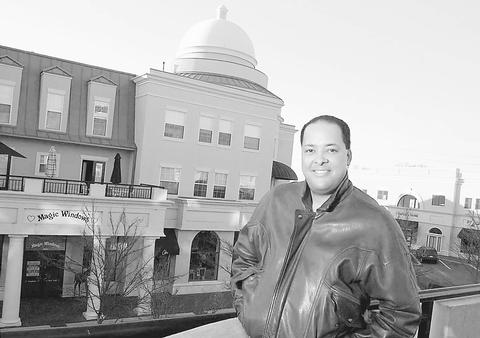Christine Franz, 35, a software consultant who looks like Meg Ryan, was exactly what developers had in mind when they started Santana Row, a Silicon Valley crest in the latest, most ambitious wave of shopping malls.
Franz, demographic perfection, stared out through fashionable sunglasses at the muddy Main Street of the 85,000㎡ site, now concrete and steel. By August, when the US$475 million "lifestyle village" is scheduled to open, Santana Row's 17 city blocks will boast 100 specialty shops, including Gucci, Tourneau and Burberry.
But shopping is only the start. Santana Row will also be home to the people who live above the stores in 1,200 studios, lofts, town houses and villas.

PHOTO: NY TIMES
Welcome to mall-town America. You can now drop where you shop, a few steps upstairs.
Santana Row is the largest example nearing completion of a new hybrid of retail development and housing that has seized the imagination of the shopping center industry in the last year, just as regional megamall developments have begun to lumber and older suburban strip malls sputter and die.
More than a dozen such malls are breaking ground nationally, in Cincinnati; Littleton, Colorado; Richmond Heights, Montana; and elsewhere. Developers and municipalities say they have the potential for profit, reinventing dead retail property in older suburbs. Open-air and upscale, with Main Street-style architecture, they are intended to appeal to young professionals with expensive brand-name tastes and retirement-ready empty nesters looking for downtown's retail sophistication.
Commercial developers like to call these shopping villages "communities." The affluent, amenity-laden life as a salable daydream has a familiar history, whether as housing at the edge of the golf-course green or condominiums at the tennis club.
Franz was, to a corduroy-collared, denim-jacketed T, a prime prospect on Santana Row's open-house tour. "Forgive me for sounding snobbish," she said. "But the retail sounds like it's going to be top-notch." A 3,716m2 Crate & Barrel will sell the welcome mats.
Fred Smith, 52, an engineer on the tour with Franz, said: "It's fantastic. I could go downstairs to Starbucks for coffee, then come back upstairs and work on my computer, then go back down to Chili's for dinner."
Smith is the other side of Santana Row's demographic silver dollar: baby boomers on the brink of retirement, looking for a last place to live -- 20 million of them turning 55 within the next two years.
"And shopping-wise, it's very nice not to have to drive," said Annette Hamon, 55, a graphic artist who owns a house in Cupertino. "I'd like to live someplace where you don't have so much upkeep yourself."
The builder of Santana Row, Federal Realty Investment Trust, a retail-property developer based in Rockville, Maryland, with US$2.5 billion in assets, compares the mall's mix of shopping and living to a typical neighborhood in New York.
But urbanists debate whether the demography of a private development pinned specifically to upscale shopping and dining will actually invite the true diversities of metropolitan life, while retailers weigh the risk that upstairs residents with eyesore tastes in window curtains could ruin their sales image below.
Santana Row's developers are giving stores the option to dress the residents' windows above, in certain buildings. The 560m2 Gucci may, if it chooses, install blinds in the apartments that will display retail logos when pulled down, said Marc McQuain, the retail development manager -- an ultimate brand extension that may or may not bother residents, depending upon the strength of their shopping allegiances.
"At the end of the day, it's a shopping center," said Barbara Lamour, 29, touring with her father, Will Heiduk, a retired engineer. "It's not a community. It's a business."
Santana Row, though it will have street mimes and strolling mandolin players, will not have public parks, day care or senior-citizen centers, schools or community boards. And its retail tenants will be well tailored to the tastes of residents whose incomes will support the proposed rents -- US$1,500 to US$10,000 a month. Dean & DeLuca, not Safeway, will be the corner grocery. Santana Row will have no church, but there will be an imported 18th-century French chapel, selling flowers.
Lifestyle villages are rapidly eclipsing in scale and civic posture earlier, smaller residential-shopping developments like Mizner Place, in Boca Raton, Florida, built in 1988. The Streets of West Chester in suburban Cincinnati and Birkdale Village, a 210,444m2 shopping and residential community outside Charlotte, North Carolina, have also broken ground in the last year. Housing is also being integrated, as a second phase, into many of the 25 existing open-air, upscale shopping malls that developers call "lifestyle centers," to convert them to villages.
A PriceWaterhouseCoopers report on shopping malls issued last year estimated that 18 percent of the nation's 2,800 malls are dead or dying as commercial ventures. It cited aging malls' inability to compete with newer malls that provide a stronger draw with movies and other recreation, and increasing dissatisfaction among suburban shoppers bone-tired of highway trips and traffic. Lifestyle centers, many planned to include residences, are replacing them. Santana Row, which sits at an intersection with two other malls, is being built on the site of the former Town and Country Mall, now the mud of its new Main Street.
With one third the retail space of existing regional megamalls, which have a million square feet or more, these hybrids exclude "big box" department stores like Macy's as anchors, considered mass-market merchants, preferring higher-end chains like Williams-Sonoma, which owns Pottery Barn.
Small examples of centers with retail and residence integration, like Phillips Place in Charlotte, developed in 1997, have succeeded at maintaining a high level of the right, exclusive retail tenants and a high level of resident occupancy -- 90 percent at Phillips Place.
"There is `city' life, and there is `some' life, and there is `no' life -- the suburbs," said Dr. Keoni Udarbe, 34, who lives in a one-bedroom apartment above Cradle and All, a baby-goods shop at Phillips Place. "If I need to have a dinner party, I can walk to Dean & DeLuca." Udarbe, a psychiatric pediatrician who moved from New York City, had no problems with the urban character of his new home, including the December toy drive in the courtyard and the week of ho-ho-hoing below his balcony. "But it's not like living in the city. I lived in the city -- and this is not close."
Christopher Cole, a director of development on the East Coast for Terranomics Development, a retail development company based in New Jersey, said that interest in projects like Santana Row "is driven by municipalities wanting urban centers, where you live and shop in the same neighborhood."
Susan F. Shick, the executive director of the San Jose Redevelopment Agency, which rezoned Santana Row's land to allow both housing and shops, said, "When a developer comes in with more retail -- and high end -- why would you say no?" Centers like Santana Row, she said, can create a profitable synergy of uses for developers and a high tax base for the neighborhood, but also, potentially, a hellishly high density of people and cars at a single site.
In Rochester Hills, Michigan, the Village at Rochester Hills, a lifestyle center now being built, was not allowed residences in its plan largely because of the congestion they stood to create.
"The whole area's bursting at the seams," said James Fielder, vice president for acquisitions for Robert B. Aikens & Associates, the developer. "It was shot down in discussions with the municipality. I didn't think it had a snowball's chance it would go through."
What gives developers any confidence that there is a market for shopping mall villages?
"This is the American cultural response to boredom with the suburbs," said Alex Krieger, chairman of the department of urban planning at the Harvard Graduate School of Design. "Clothing suburbia in urban mannerisms, for a market of people who think it's funky to have restaurants and shops downstairs -- it's a great marketing gimmick, but it's pretend urbanism."
"What the developers don't bank on," he added, "is that if it succeeds, those folks above Banana Republic and Pomodoro's will start complaining about longer shop hours, liquor licenses, pedestrian traffic. It's succeeding now because it's a novelty."
Retailers also question the idea's basic equations.
"For developers it works, because it adds a good-sounding thing to the economic package," Howard Lester, chairman of Williams-Sonoma, said. "But I don't think residential means a heck of a lot to retailers. I need 80,000 households to drive a Pottery Barn or Pottery Barn Kids." Lester, who is not joining Santana Row because he already has shops in a mall across the street, added, "I don't know if the fact people are living above makes it more attractive to me as a customer."
On a recent Sunday at Santana Row, a dozen shoponauts stomping up the concrete steps to view model apartments, presented a diversity of opinion.
"It's going to attract single people, with fewer attachments," said Karen Dalal, 33, who lives in a ranch-style house a mile away. "I mean, I have a couple of dogs. I'm not going to bring them into a community like this."
Laura Ward, 32, on tour with her partner, Brent Gregersen, 31, said, "For me, personally, because I have two children, it just doesn't seem like it will be right."
Neither dog runs nor playgrounds are in the plans at Santana Row.
But there will be a Starbucks and a Chili's and 19 other restaurants, said Steven J. Guttman, chairman and chief executive of Federal Realty Investment Trust.
"It's a good example of how the market for something as mundane as housing has changed from a good that somebody buys to a package of services, only one of which is a residential living space," said Peter Francese, founder of American Demographics magazine.
"The people doing this have realized that `it's the amenities, stupid,'" he said. "What do people want in a lifestyle -- not what do people want in a four-walled box."
Robert Gibbs, a retail consultant who helps developers incorporate urban thinking into suburban projects, says that aging baby boomers might well prefer the mall as a mailing address.
"They're coming onto the market looking for smaller multifamily luxury housing in town," he said. "They spent their lives in suburbs, driving their kids to soccer. They want to be able to walk to shops and restaurants. Their tax advisers are telling them they don't have to own a home -- because they don't need the tax deduction -- but to sell the four-bedroom US$400,000 empty nest, put the money in the bank, rent a US$2,000 apartment and live on interest."
Gibbs added dryly, "The smarter new shopping centers know this."
Franz, the software consultant, wasn't packing up house just yet.
"This is huge -- it's like a mall," she said, looking up Santana Row's dirt avenues. "How do you find comfort living at the mall?"

LONG FLIGHT: The jets would be flown by US pilots, with Taiwanese copilots in the two-seat F-16D variant to help familiarize them with the aircraft, the source said The US is expected to fly 10 Lockheed Martin F-16C/D Block 70/72 jets to Taiwan over the coming months to fulfill a long-awaited order of 66 aircraft, a defense official said yesterday. Word that the first batch of the jets would be delivered soon was welcome news to Taiwan, which has become concerned about delays in the delivery of US arms amid rising military tensions with China. Speaking on condition of anonymity, the official said the initial tranche of the nation’s F-16s are rolling off assembly lines in the US and would be flown under their own power to Taiwan by way

CHIP WAR: The new restrictions are expected to cut off China’s access to Taiwan’s technologies, materials and equipment essential to building AI semiconductors Taiwan has blacklisted Huawei Technologies Co (華為) and Semiconductor Manufacturing International Corp (SMIC, 中芯), dealing another major blow to the two companies spearheading China’s efforts to develop cutting-edge artificial intelligence (AI) chip technologies. The Ministry of Economic Affairs’ International Trade Administration has included Huawei, SMIC and several of their subsidiaries in an update of its so-called strategic high-tech commodities entity list, the latest version on its Web site showed on Saturday. It did not publicly announce the change. Other entities on the list include organizations such as the Taliban and al-Qaeda, as well as companies in China, Iran and elsewhere. Local companies need

CRITICISM: It is generally accepted that the Straits Forum is a CCP ‘united front’ platform, and anyone attending should maintain Taiwan’s dignity, the council said The Mainland Affairs Council (MAC) yesterday said it deeply regrets that former president Ma Ying-jeou (馬英九) echoed the Chinese Communist Party’s (CCP) “one China” principle and “united front” tactics by telling the Straits Forum that Taiwanese yearn for both sides of the Taiwan Strait to move toward “peace” and “integration.” The 17th annual Straits Forum yesterday opened in Xiamen, China, and while the Chinese Nationalist Party’s (KMT) local government heads were absent for the first time in 17 years, Ma attended the forum as “former KMT chairperson” and met with Chinese People’s Political Consultative Conference Chairman Wang Huning (王滬寧). Wang

CROSS-STRAIT: The MAC said it barred the Chinese officials from attending an event, because they failed to provide guarantees that Taiwan would be treated with respect The Mainland Affairs Council (MAC) on Friday night defended its decision to bar Chinese officials and tourism representatives from attending a tourism event in Taipei next month, citing the unsafe conditions for Taiwanese in China. The Taipei International Summer Travel Expo, organized by the Taiwan Tourism Exchange Association, is to run from July 18 to 21. China’s Taiwan Affairs Office spokeswoman Zhu Fenglian (朱鳳蓮) on Friday said that representatives from China’s travel industry were excluded from the expo. The Democratic Progressive Party government is obstructing cross-strait tourism exchange in a vain attempt to ignore the mainstream support for peaceful development